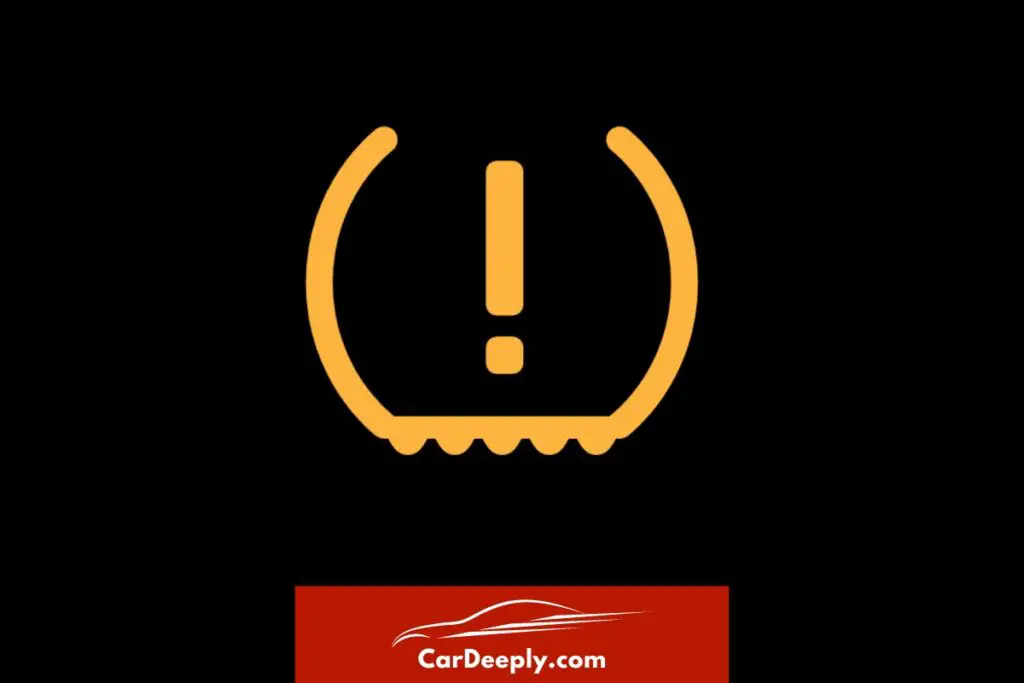Ever had that pesky tire pressure light flash on your dashboard and felt a pang of panic?
Don’t worry!
This guide is your lifesaver, saving you from the following:
- Misunderstanding your TPMS
- Ignoring crucial warning signs
- Making common tire pressure mistakes
Dive in to discover the ins and outs of your tire pressure warning light and how to handle it like a pro!
Advertising links are marked with *. We receive a small commission on sales, nothing changes for you.
Key Takeaways
- The Tire Pressure Monitoring System (TPMS) alerts you to low tire pressure.
- Low tire pressure, TPMS malfunction, cold weather, and new tires can trigger the light.
- Altitude can affect your tire pressure and TPMS.
- Checking tire pressure and resetting the TPMS light are crucial steps.
- Proper tire pressure maintenance ensures vehicle safety and efficiency.
Understanding the Tire Pressure Monitoring System (TPMS)

Ever wondered what that little light on your dashboard is trying to tell you? Your car’s Tire Pressure Monitoring System (TPMS) is speaking up!
This nifty system is your vehicle’s way of keeping tabs on the air pressure in your tires.
What is TPMS?
In a nutshell, TPMS is your car’s tire pressure watchdog. It’s a system that most modern vehicles come equipped with.
Its job?
Keep an eye on the air pressure in your tires, and give you a heads-up if it falls below a certain level.
How does TPMS work?
The TPMS uses sensors located in each tire to measure the pressure.
If the pressure falls below the recommended level, usually around 25% below the standard 30-35 PSI for passenger vehicles, it sends a signal to the dashboard display or a warning light.
Why Does the Tire Pressure Light Come On?
Now that we’ve got the basics down, let’s dive into why your tire pressure light might come on.
Low tire pressure
The most common reason is, of course, low tire pressure. If one or more of your tires is underinflated, the TPMS light will alert you. Underinflated tires can lead to a host of problems, including:
- Poor handling
- Reduced fuel efficiency
- Increased tire wear
TPMS malfunction
Sometimes, the TPMS itself might be the culprit. If the system malfunctions, the light may come on even if your tire pressure is normal.
If you see the tire pressure light and your tires seem properly inflated, having the TPMS checked by a mechanic is a good idea.
Cold weather
Did you know that cold weather can cause your tire pressure to drop? The air inside your tires contracts as the temperature drops, which can cause the pressure to fall below the recommended level.
If you see the tire pressure light come on in cold weather, it’s a good idea to check your tire pressure and inflate your tires if needed.
New tires
If you’ve recently had new tires installed on your vehicle, the TPMS light may come on as the system adjusts to the new tires. This is usually temporary, and the light should go off quickly.
If the light doesn’t go off, it’s a good idea to have the TPMS checked by a mechanic.
Effects of Altitude on Tire Pressure Sensors
Lastly, let’s talk about altitude. Yes, you read that right – altitude can affect your tire pressure! The air is thinner at higher altitudes, which can cause the air pressure in your tires to drop.
This is especially important to consider if you drive in a mountainous area or at high altitudes. It’s a good idea to check your tire pressure more frequently when driving at high altitudes and inflate your tires to the recommended level if necessary.
What to Do When the Tire Pressure Light Comes On
Alright, you’re cruising along, and suddenly, that tire pressure light pops up on your dashboard. What’s the next move? Let’s break it down.
Immediate Steps
First things first, don’t panic! The tire pressure light is a warning, not a command. You don’t need to pull over immediately, but you should take action as soon as possible.
If you’re on the highway or in heavy traffic, driving for a short distance is generally safe to find a safe place to pull over.
Checking Tire Pressure
Once you’ve found a safe spot, check your tire pressure first. You can do this using a tire pressure gauge or looking at the tire sidewall. If your tires are underinflated, inflate them to the recommended level.
If your tires are properly inflated, and the TPMS light is still on, it’s a good idea to have the system checked by a mechanic.
How to Reset a Tire Pressure Light
So, you’ve checked your tire pressure and inflated your tires as needed, but that pesky TPMS light is still on. What now?
It’s time to reset it.
Steps to Reset the TPMS Light
The process for resetting the TPMS light varies depending on your vehicle, so it’s a good idea to consult your owner’s manual for specific instructions.
Here are some general steps you can follow:
- Locate the TPMS reset button or tool.
- Turn the ignition key to the “on” position.
- Press and hold the TPMS reset button.
- Release the button.
- Turn the ignition key to the “off” position.
- Start the vehicle and check the TPMS light.
Consult your owner’s manual or a mechanic if the light is still on.
Frequently Asked Questions about Tire Pressure Lights
Let’s tackle some of the most common questions related to tire pressure lights.
At what PSI will the low tire pressure signal come on?
The low tire pressure signal occurs when the pressure falls below 25% of the recommended level, usually around 30-35 PSI for passenger vehicles.
Could my tire pressure warning light go on if my tire is overfilled?
Yes, it’s possible. Overinflated tires can cause problems, including poor handling and increased tire wear.
Why is my tire pressure light on after filling the tires?
If you’ve recently filled your tires and the tire pressure light is still on, the TPMS sensors haven’t had time to adjust to the new pressure level. Give it a few minutes and see if the light goes off.
Conclusion: The Importance of Tire Pressure Maintenance
In conclusion, paying attention to your tire pressure light is crucial, and taking action as soon as possible if you see it come on.
Proper tire pressure is vital for your tires’ safety, performance, and lifespan. By taking care of your tires and monitoring their pressure, you can ensure your vehicle runs safely and efficiently.
Remember, preparation is the key to success!

Sebastian loves convertibles and drove a BMW 335i for a long time (325 hp is just a dream). Today, with two children, he is more concerned with SUVs and family-friendly vehicles. In addition to an Audi A4 Avant, he also drives a Cupra Formentor VZ – even as a family man, you can’t do without speed. Get to know Sebastian better and visit the About Us page.
Advertising links are marked with *. We receive a small commission on sales, nothing changes for you.
